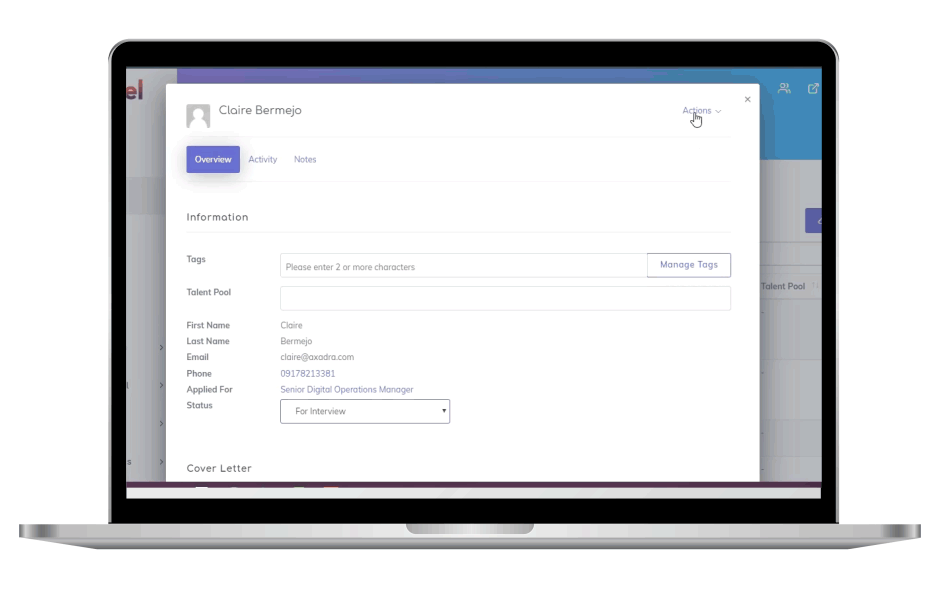Employers must work harder than ever in today’s competitive job market to find and keep the best employees. For hiring managers, this means finding more effective recruiting methods rather than sticking with the traditional way. What should they do? They must stay updated with the latest recruitment trends to maintain a competitive advantage.
From technological advancements to employer branding, here are the hiring trends you should keep an eye on.
Talent Acquisition Trends to Look Out for in 2023
The old ways of finding employees are dwindling in importance in today’s business world. And with the COVID-19 pandemic still in action, physical recruitment is still not viable for many. Luckily, technology has made it easier for hiring managers to find qualified people almost anywhere.
If you’re looking to hire top talent, follow these recent trends in recruitment:
Conducting Remote Interviews
Remote interviews aren’t a new trend. Since the pandemic, virtual interviews have surpassed in-person ones as the gold standard for preliminary candidate evaluation. Hiring managers conduct remote interviews using video conferencing apps such as Zoom, Google Meet, and MS Teams.
Additionally, 82% of employers preferred virtual interviews during the early stages of COVID-19 lockdowns. Here are a few reasons why many employers favor this recruitment trend:
- Remote interviews speed up the hiring process
- Remote interviews save time and are accessible to out-of-town applicants
- It lessens operating costs for going to and using the office to interview applicants
- Hiring managers can incorporate online assessments to help filter applicants
- It promotes a collaborative hiring process making it easier for departments to participate in the selection process
Potential applicants also benefit from remote hiring. Many job seekers favor virtual interviews because they can be conducted from the comfort of their homes. They can also save on travel expenses for many in-office interviews. With remote interviewing, they can schedule as many interviews as they want without leaving home and breaking the bank.
Although many businesses have reopened in the last year, remote work is thriving and has grown significantly since the pandemic. As a result, this talent acquisition trend is expected to continue well beyond 2023.
Focusing on Data-Driven Recruiting
Although not new, recruiters anticipate this recruitment trend to persist in the coming years. Data-driven hiring is a process where businesses find new employees with the help of data. The companies’ data usage varies considerably according to their specific requirements. Information gathered in this way comes from various sources, including social media profiles and online job boards. Companies that need to hire more people quickly can significantly benefit from using data-centric recruiting. Businesses can save time and effort by using data-driven recruitment to sift through applicant pools when hiring remote workers.
Utilizing Social Media Recruiting
Since its popularity in the early 2000s, social media has become a thriving center of possibilities. Human resource professionals now use social media recruitment to source candidates. This 2023 recruitment trend uses social media sites such as Facebook and Twitter to find, attract, connect, and hire potential employees. While there are job-posting websites, the response rate to job ads on social media is much higher since 59.3% of the global population uses social media.
In the coming years, more and more companies will likely use social media to find new employees. Sites like LinkedIn cater specifically to the business community and are teeming with qualified candidates for employment. When you search for LinkedIn profiles, you’ll see applicants with no prior work experience but are eligible for the position because of their skills. Also, this trend in hiring gives companies a chance to learn about the past, interests, and career goals of potential employees.
Targeting Recruitment Efforts Toward the Younger Generation
A growing number of young professionals will enter the workforce this year. With the labor force continuing to grow and change, hiring millennials and Gen Z will become even more critical to find good workers. Businesses must rethink how they hire people and run their businesses.
Here’s how hiring managers can keep up with the recruitment trend for younger employees this 2023:
- Take advantage of technological advances by conducting interviews and hiring remotely to speed up the process
- Emphasize the company’s culture, such as work-life balance, autonomy, and teamwork, as these are the primary attributes desired by the younger generations.
- Provide them with opportunities for advancement, like training and development, to keep them from jumping from job hopping
Supporting Gig Work
Another recent trend in recruitment is the employment of contingent or gig workers. Gig workers are independent contractors or freelancers who work for a limited time, depending on a project’s duration. They sign formal contracts with companies that hire them to do project-based work.
As more people seek out temporary or contract work, the gig economy is predicted to thrive in the years to come. Since today’s workforce lives in the digital age, everything is mobile and more people can work remotely. Many workers also find gig work more flexible and financially rewarding than traditional employment.
Finding, recruiting, and bringing gig workers on board differs from hiring full-time employees. For instance, some companies use a vendor management system (VMS) to hire independent contractors. A VMS is a cloud-based software platform that helps global enterprises find, engage, and manage external contractors and service providers.
Even though VMSs can be helpful, companies should also be prepared to use tools like social media and career sites to find and hire contingent workers. This will make it easier to narrow down the pool of candidates and find the best person for the position.
Leveraging Artificial Intelligence
Artificial intelligence (AI) is rising across many sectors, including the employment market. Companies are increasingly turning to this 2023 recruitment trend to improve things, like streamlining the hiring process.
For example, recruiters can use AI to scour sourcing platforms such as LinkedIn and Indeed for qualified candidates. Businesses can use AI to help them screen and filter candidates, allowing them to quickly and efficiently identify the best candidates. Similarly, AI can identify the traits of successful candidates for a given role and then seek them out. It’s smart enough to determine if an applicant is qualified based on skills, education, and work history.
Recruiting chatbots are one of the most effective AI tools for getting to know a candidate better without wasting time. It’s a form of automated messaging that can help you sort potential employees as they explore your career site. A recruiting bot can also answer questions about the company’s policies, benefits, and the next steps of the application process. A team responsible for talent acquisition may use chatbots to turn job seekers into candidates and applicants.
The AI tools we have today have yet to be fully automated, but they can be taught to perform many of the duties we once performed manually. This entails maintaining database structures that facilitate quick data retrieval.
Using Robotic Process Automation
In 2023, more staffing and recruiting agencies will use automation to make administrative tasks easier and less repetitive. With robotic process automation (RPA), bots can complete various time-consuming recruiting tasks. Robotic process automation (RPA) automates repetitive tasks at scale without the need for human intervention. For instance, verifying many candidate documents at once is time-consuming but can be done without the intervention of a human. A bot can check each record and send the results to an applicant tracking system. Recruiters who follow this 2023 recruitment trend can save time and money.
Want to keep up with this hiring trend? Try our free applicant tracking system that makes hiring more efficient. It has a candidate management feature that can help HR departments track the progress of individual applicants and make the process easier for everyone involved.
Improving Candidate Experience
Talent acquisition trends place great importance on candidate experience. Increasing the quality of the candidate experience is a key factor in enhancing the overall recruitment and hiring process. More people will be encouraged to apply when they know they’re already valued at the beginning of their application.
Here are some ideas to enhance the application process for prospective employees:
- Make your career websites mobile-friendly, simple, and easy to navigate
- Make sure the application process is available to all interested applicants
- Ensure applicants can track their progress
- Maintain transparency throughout the application process
- Practice employer branding on emails, job postings, and marketing campaigns
- Update applicants about potential job openings
- Assist applicants throughout the application process
This hiring trend doesn’t end here. It continues after a job applicant has been put in the candidate pool. Applicants also see a company’s professionalism based on how well they’re treated during the interview and follow-up processes of the application. Don’t forget that the overall experience is essential if you want to attract, keep, and build a stronger employer brand.
Boosting Diversity in the Workplace
In 2020, 76% of job seekers stated that workforce diversity is a significant factor when reviewing applications and job offers. Now, hiring managers are also paying more attention to diversity and inclusion because of their impact on the ability to find and hire top talent. Diversity and inclusion in the workplace have been shown to boost both profits and productivity. As companies try to make their workforces more diverse, it’s the recruiters’ job to find and consider candidates from a broader range of backgrounds.
Check out the following strategies to stay on top of this hiring trend in 2023:
- Use a blind hiring method to eliminate bias right from the start of the process
- Examine job postings for requirements that unintentionally exclude diverse candidates
- Make an effort to promote your company as a diverse workplace
Implementing Flexible Schedules
In the coming years, flexible working arrangements will become the new normal. More employers now offer flexible work options to boost productivity and cut costs. Similarly, many people in the workforce are looking for roles that provide flexible scheduling. This is because adjustable work hours improve work-life balance, creativity, and morale.
A company that follows this talent acquisition trend will stand out to potential employees because it provides them with an opportunity unavailable at other businesses.
Stay Ahead of the Game With the Latest Recruitment Trends
The global pandemic and technological advancements caused a change in the recruitment process over time. Despite the uncertain future of the recruiting industry, these 2023 recruitment trends will assist businesses in finding and hiring the best people. By providing remote work, targeting the younger generation, using AI and RPA, increasing workplace diversity, and improving the candidate experience, companies can soon attract and retain competent workers.
Ready to stay in the competitive recruitment market? Contact us today for any questions, and we’ll gladly discuss the latest recruitment trends with you.


















